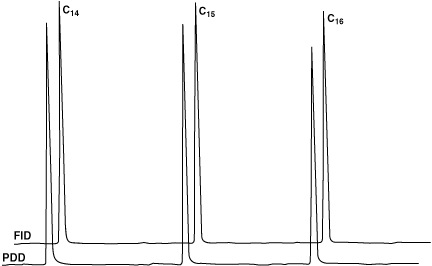Hydrocarbons - Comparing the PDD with an FID
A flame ionization detector (FID) is the typical choice for hydrocarbon analysis. The upper chromatogram shows an FID run of C14, C15, and C16. The lower chromatogram shows the same run on a PDD under identical conditions. The PDD offers comparable performance, achieved without the use of flame or combustible gases. And since the PDD's response is universal, it detects permanent gases, aldehydes, and inorganic compounds like H2S and COS, which cannot be detected by the FID.

Courtesy of Dow Chemical, Canada
Western Canada Operations, Analytical Sciences, Jim Luong
| Run conditions | ||
|---|---|---|
| Sample | 1 µl of a test mixture of C14, C15, and C16 in hexane | |
| Injector | 80:1 split | |
| Detector mode | Helium photoionization | |
| Discharge gas | Helium | |
| Dopant gas | None | |
| Detector temp | PDD | 350°C |
| FID | 250°C | |
| Column | 100% dimethylpolysiloxane, 30m x 0.32mm x 0.25µl | |
| Column temp | 150°C | |
| Attenuation | 1 | |

